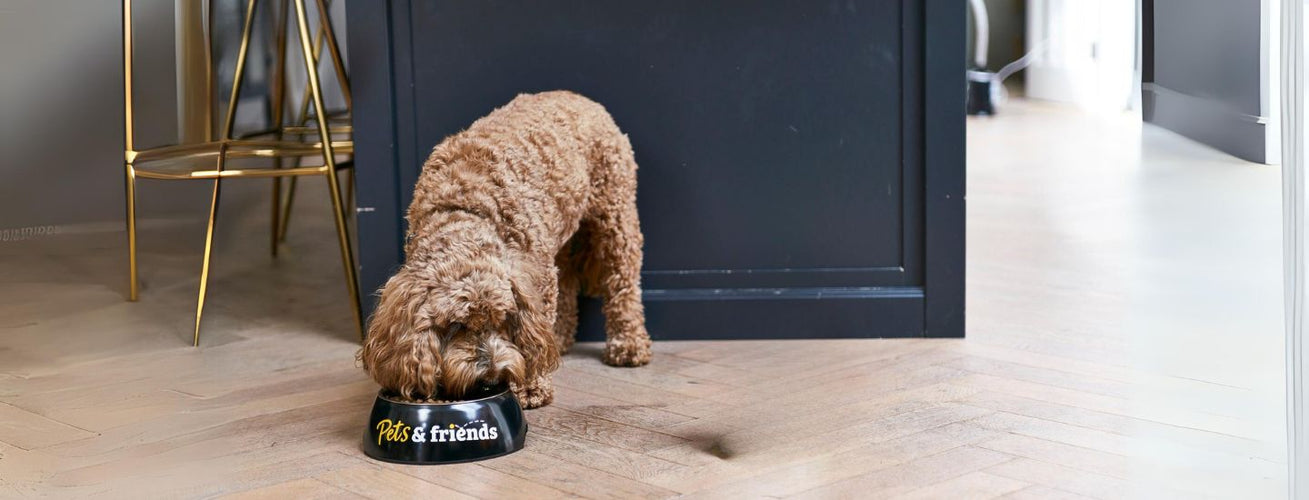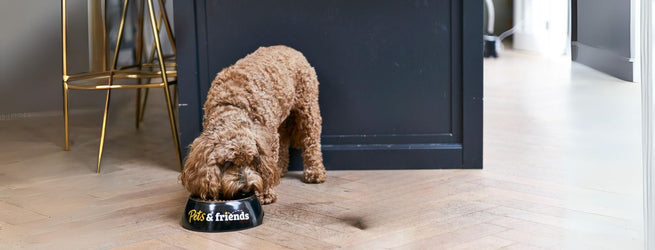

Posted by Emma Oldroyd, on
Five Signs You May Need to Switch Your Dog’s Food
As pet parents, we all want what’s best for our pooches, that’s why it’s important to look for the signs that it’s time to switch your dog’s food.
Whether it’s a physical sign, or they simply want to enjoy a wider variety of food, there are a number of reasons to consider changing their diet.
Our experts have put together a short guide to answer your questions about changing your dog’s food, and what to look out for.

- Age
Usually, the first time you will change your dog’s food is once they reach adulthood. Many dog food recipes are formulated for life stages, so they get the right amount of nutrients for their age. Different dog breeds reach adulthood at different ages, so it’s always a good idea to speak to our pet experts about when to change their puppy food to adult dog food.
Puppies start to become adults any time between 6 and 12 months and can end between 18 and 24 months. Once their bones have fully developed and they’ve reached their final height and size.
- Boredom or food aversion
Dogs, like humans, can get bored with their food over time. If your dog consistently refuses to eat their current food or shows signs of disinterest during mealtimes, switching things up may help reignite their appetite.
If this is the case, it could be that they no longer enjoy the flavour of the recipe they’re eating. Thinking about changing dog food flavour? The main source of flavour in dog food recipes is the protein, so trying a different protein source may bring them back to their bowl.
Switching between recipes within the same dog food brand shouldn’t cause your dog any upset (providing they don’t have an underlying intolerance to certain proteins) as some good quality dog food brands like Collards use a set recipe and switch out the proteins to offer variety, so you can easily switch from turkey to lamb for your dog to enjoy.
Top tip: Lookout for the word flavour. If your dog food states that it is ‘turkey flavoured’, this means there doesn’t have to be any turkey in the recipe at all! If you’re unsure about flavours and recipes, our pet experts are here to help. Simply ask in-store or online via Pets Chat.
If your dog is fed a single complete meal (either wet or dry) and suddenly no longer wants their dinner, mixing dry and wet dog food or changing the texture can create a whole new experience for them to enjoy. There are a few ways to do this including:
- Adding in wet food to dry meals as a topper such as Collards, Natures Menu or Naturo
- Adding in dry food to a wet dinner for some crunch
- Mixing in warm water or a gravy topper like Furr Boost to your dog’s kibble to soften the texture
- Microwaving your dog’s dry food for a few seconds to release the protein-filled aromas (remember to let the food cool before serving)
- Using puzzle feeders or lickimats to serve up dinner so your dog has a challenge to eat all their food and encourage them to eat more slowly. This will offer positive mental stimulation as they eat, which they’ll associate with dinnertime- helping them to enjoy food again.

- Allergies or food sensitivities
Over time, dogs can develop intolerances or allergies to certain ingredients within their food. The common signs include stomach upsets, moulting, itching or skin irritations. Our pet experts will be able to advise on common intolerances and could offer alternatives for your dog to try.
We would always recommend a trip to the vet to be sure of any potential sensitivities, especially if stomach upset continues.
- Changes in behaviour or activity levels
Some ingredients can also change a dog’s behaviour, especially if this is teamed with changes in their activity levels. For example, if your dog eats food which is higher in carbohydrates and fat and is no longer walking as far as they used to, they could gain weight or become more hyperactive in the need to burn off all that energy. Whilst this is entirely dependent on your pet, it’s important to find the right food balance to keep them happy and healthy.
Some dog food brands like Skinners or Dylan offer specific recipes for dogs who have different activity levels such as working dogs.
- Unusual poo
For all dogs, the result of a diet which no longer suits them is their poo. A change in their stools usually means something isn’t quite right, and once other factors are eliminated it could be time to switch their food to help.
We always recommend speaking to your vet if your dog is showing signs of any digestive upset which lasts longer than 48 hours to ensure there are no long-term health issues causing the upset.
Whatever the reason is, if you need to switch your dog’s food, we’re here to help. We offer a number of tools to help you find the ideal diet for your dog including our personalised pet nutrition plan which you can discover both online and in-store.
Our pet experts are on hand to help in-store or via our live chat box, and you can also find advice on switching your dogs’ food over on our blog.
